
By Chuck Meide, Expedition Principal Investigator - Lighthouse Archaeological Maritime Program
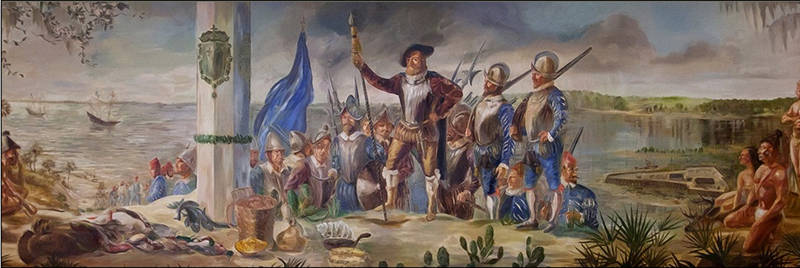
Ribault’s Landing, a 31 by 8 foot mural by Jacksonville artist Lee Adams, on display at Jacksonville’s Main Library. Image courtesy of Jacksonville Public Library. Download image (jpg, 303 KB).
In early 1562, the Admiral of France, Gaspard de Coligny, convinced France’s Queen Mother Catherine de Medici to finance a colonization expedition to “La Floride.” Catherine was eager to assert France’s territorial claim to North America, and to seize the opportunity for increased commerce and an influx of valuable resources, including perhaps vast deposits of precious metals. In addition, the planned settlements, which were envisioned as providing a refuge for Protestant Huguenots, were seen as a way to ease religious conflict which had been tearing the country apart.
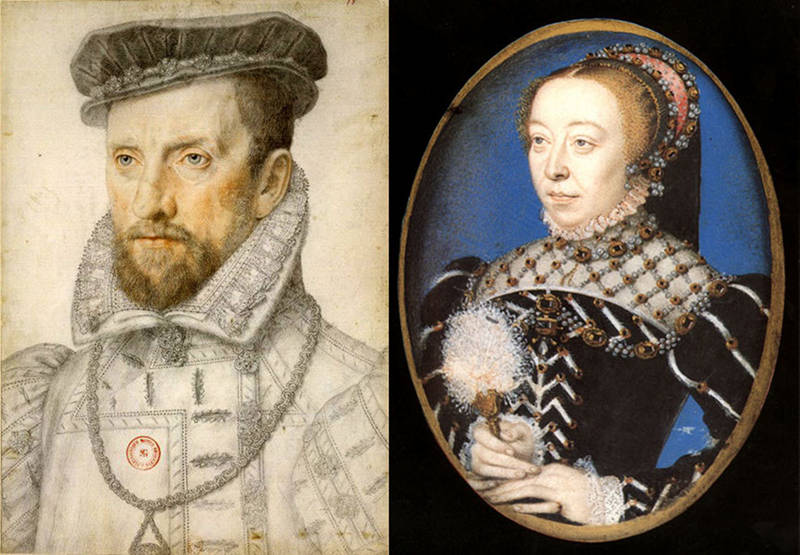
Left: Gaspard de Coligny, Admiral of France, nobleman, and leader of the Huguenots. While he fought against the crown during the Wars of Religion, during times of peace he worked closely with the monarchy and was responsible for the organization of the France’s colonization efforts in Florida. Right: Catherine de Medici, Queen Mother of France, who ruled as regent during the first colonization attempt in Florida. She continued to wield great influence over state policy after her son Charles IX came of age in 1563. Images courtesy of Wikipedia. Download larger version (jpg, 331 KB).
Coligny, a Huguenot leader, had prompted an earlier, unsuccessful French Protestant settlement attempt on the coast of Brazil in 1555. This time around, the endeavor was to be made in Florida, which was perfectly situated for potential strikes along Spain’s treasure flota route or raids in the Spanish Caribbean.
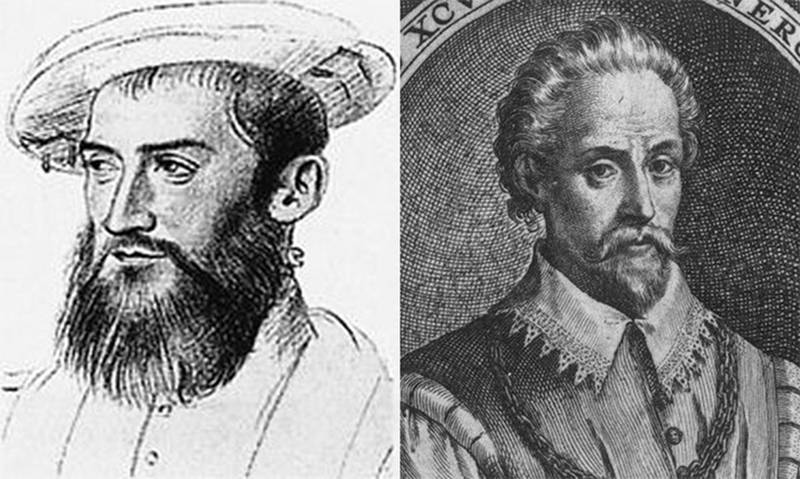
Left: Artist’s depiction of Jean Ribault. Right: René de Laudonnière. Ribault image courtesy of Jean Ribault Facts; Laudonnière image courtesy of Wikipedia. Download image (jpg, 142 KB).
The well-known sea captain Jean Ribault, of Dieppe, was chosen to lead the expedition, with Captain René de Laudonnière as the second in command. Nicolas Barré, who had navigated Florida waters during the 1555 settlement attempt, would serve as chief pilot. A crew was assembled at Havre-de-Grâce for either two or three ships. Armed with as much as 25 bronze cannon, the flotilla with around 150 men departed France on 18 February 1562.
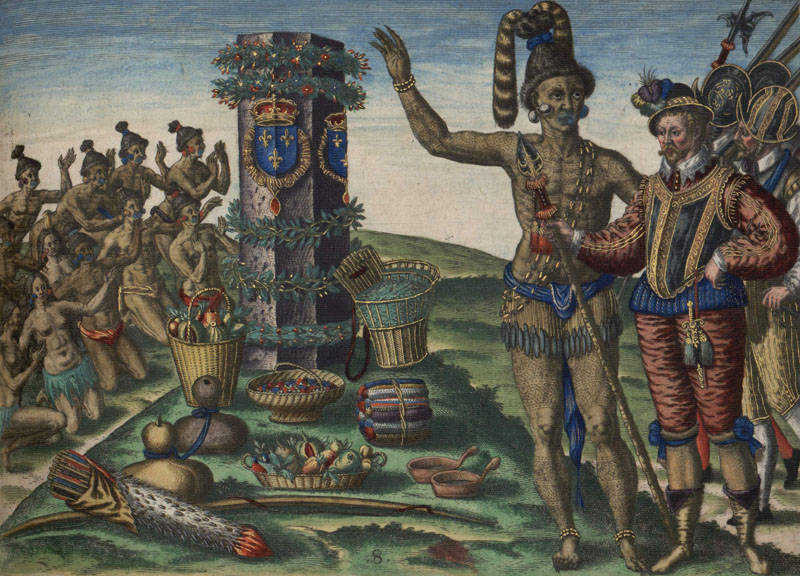
The Timucuan chief welcomes Laudonnière in 1564, showing how his people revere the stone column erected in 1562 by the French at the River of May. This image is one of the Theodore de Bry engravings, from artwork by Jacques Le Moyne, who was with the 1564 expedition. Image courtesy of the Service Historique de la Défense, Vincennes, France. Download larger version (jpg, 302 KB).
After crossing the Atlantic along a circuitous route to avoid Spanish warships, the coast of Florida was sighted. On the first of May, the flotilla entered a newly discovered river. This was named the River of May, and is known today as the St. Johns River which bisects the city of Jacksonville.
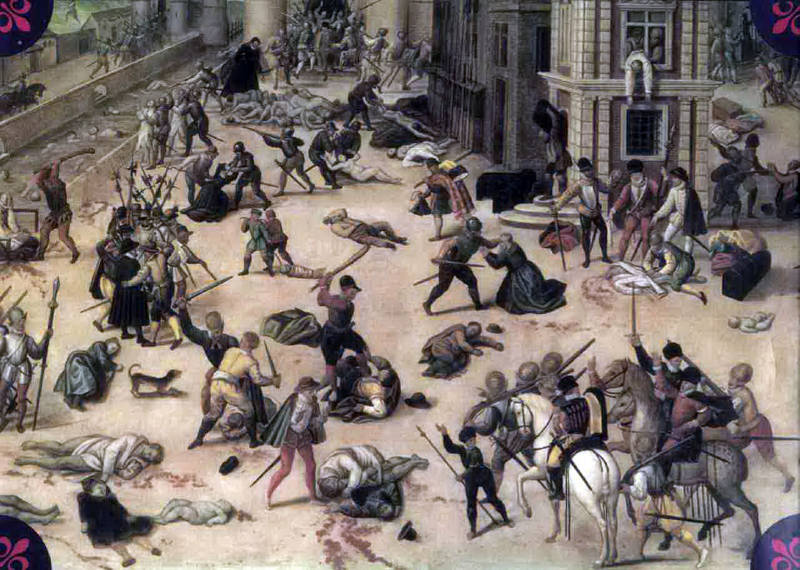
Ribault and Laudonnière returned to France after the first colonization attempt to find the country embroiled in a religious civil war, known as the First War of Religion. Open hostilities between Catholics and Huguenots had broken out in March 1562, just a month after the expedition had left France for Florida, and an uneasy peace would be achieved through the Edict of Amboise in March 1563. Image courtesy of Jacksonville Public Library. Download image (jpg, 485 KB).
The Frenchmen spent several days reconnoitering the countryside, and making relations with the seemingly friendly Timucuan native peoples. After erecting a stone column on the south bank of the river to claim the land for France, the expedition departed and sailed north, exploring the Georgia and Carolina coastline along the way.
They decided to build a fort, named Charlesfort, at present-day Parris Island, South Carolina. Thirty men stayed behind to occupy the fort while the main group, which by this time included many reluctant colonists, returned to France.
Ribault’s intention was to gather more colonists and supplies and return to ensure the permanency of the Charlesfort settlement. But France was engulfed in a religious civil war, and as Dieppe fell Ribault fled to England, where he sought aid for the Florida endeavor from Queen Elizabeth. While in London, on 30 May 1563, he published Whole and True Discouerye of Terra Florida, an account of his explorations in Florida.
At first supportive, Queen Elizabeth changed her mind, perhaps not wishing to antagonize her brother-in-law, Philip II of Spain. Queen Elizabeth ended up imprisoning Ribault. He spent more than a year in the Tower of London, from early June 1563 through at least fall 1564.
Meanwhile, after a year without renewed supplies and conflict both with the Natives and amongst themselves, the Charlesfort colonists faced disaster. A final desperate attempt to build a ship and sail home resulted in a miserable voyage, complete with cannibalism, before the survivors were rescued off the coast of England, and subsequently imprisoned.
Laudonnière, however, escaped persecution in France. After hostilities between Catholic and Huguenot ceased, he was chosen by Admiral Coligny to lead a second expedition to Florida.
In March and April 1564, three ships were outfitted with munitions, agricultural equipment, livestock, and supplies. Three hundred colonists, including women and men of all social backgrounds, set sail on 22 April. They sighted the River of May on 24 June.
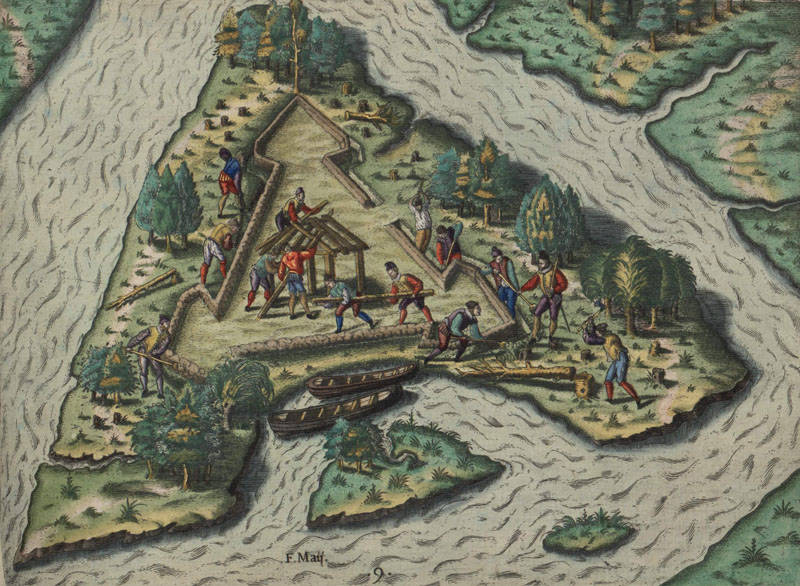
Construction begins on Fort Caroline, as depicted by Theodore de Bry after Jacques Le Moyne’s original drawing. Image courtesy of the Service Historique de la Défense, Vincennes, France. Download larger version (jpg, 303 KB).
An area on the bluffs fronting the south bank of the river was chosen for the colony, which was named La Caroline to honor King Charles. Construction began immediately on the triangular Fort Caroline, with aid provided by the friendly native peoples.
On 28 July, Laudonnière soon sent his ships back to France for more supplies and 500 additional colonists. At Fort Caroline, the settlers began to establish their new home: a flour mill, black smithy, and bakery were built, and regular religious services were established. Exploration parties combed the countryside searching for gold and other riches, to no avail. What was not prioritized was the clearing of land for planting crops. The dependence of the colony on resupply by ships from France was its fatal flaw.
The increasing scarcity of food and subsequent strained relations with the Timucuan native peoples, the lack of mineral wealth, and the general hardships of the nascent colony led to discontent among the men. The result was open rebellions and even assassination plots against Laudonnière.
In November 1564, 13 men stole a sailing barque from the colony to try their hand at piracy in the Spanish Caribbean. No sooner had two new barques been completed then another mutiny took place, this time with 66 men hijacking the vessels for piratical intents. This mutiny would have dire consequences for the colony, as it would alert Spanish authorities, who interrogated some of these captured corsairs, to the presence of Fort Caroline.

Fort Caroline after completion, as drawn by Jacques Le Moyne and reproduced by Theodore de Bry. Image courtesy of the Service Historique de la Défense, Vincennes, France. Download image (jpg, 226 KB).
By the following June, virtually all of the food supplies were exhausted, no resupply ships had arrived, and the decision was made to evacuate the colonists to France.
On 3 August 1565, however, as modifications were made to make a leaky brigantine seaworthy, four sails were sighted on the horizon. These were not French supply ships but an English fleet lead by Sir John Hawkins. The English departed after a trade with the beleaguered French: food and a sturdy vessel in return for cannon and powder from Fort Caroline.
On 28 August, just as the French were poised to abandon the colony and depart, a new set of sails appeared. The resupply fleet had finally arrived, and Jean Ribault had returned to Florida.